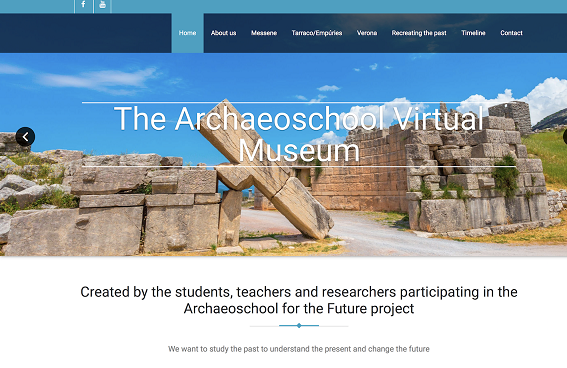This website of the Archaeoschool Virtual Museum (http://cdl3.cdl.cat/museum/), which is an initiative of the CDL team, was created in 2017.
Its goals can be summarised as follows:
– Providing our students with a tool –an online platform – that allows them to:
- analyse works of art and other elements belonging to their archaeological sites: Ancient Messene (Greece), Roman theatre in Verona (Italy), Roman ruins in Tarraco (Tarragona, Spain) and the ancient Greek and Roman cities in Empuries (Spain)
- locate those items in time and space
- find the connections among different works, objects or buildings
– Creating a website that is a permanent output of the Archaeoschool project and that can be used in the future.
Operating procedure
- Students and teachers select works or other elements belonging to their respective archaeological site.
- Then they fill in a technical sheet with the most relevant information referring to that piece and send it to the webmaster of the Virtual Museum website, who uploads the new item.
Educational activity:
Students visit the museum of interest (in our case, they have visited the museums of the 3 archaeological sites that this projects studies) and they fill the following worksheet:
After visiting the Museum ............................, please make your report about an item that you prefer:
- First group: “Labels”
- Architecture and Engineering
- Sculpture
- Painting
- Objects: ceramics, goldsmithing...
-
- Related to the daily /private life
- Related to trade
- Related to the production and preservation of goods
- Related to celebrations and public acts
- Technical data
- Name
- Author (if known)
- Date or period of production and/or use
- Building or production material
- Dimensions
- Origin
- Date since it is in the current museum or it was excavated (in case it is a monument or an archaeological site)
- Other aspects in order to better describe the work
- Purpose or usage
- Description of its basic features
- Technical challenges (if known)
- Aesthetic description /Art style
- Who ordered or kept it?
3. Other information to be provided could include the answers to the following questions:
- How can an art work be related to other similar works and link them to their historical stages and the societies that produced them?
- How difficult was to produce it? Which challenges had to be overcomed?
- How is it linked to its environment?
- How was it preserved from its date of production until today?
- What do we know about the author/s?
- What do we know about possible restoring, rehabilitation and conservation processes?
- How could we represent it geographical and historical location of the different works? Through maps? With a time line?

